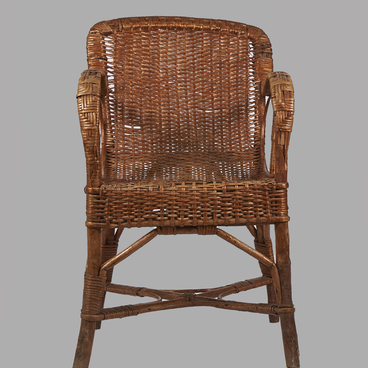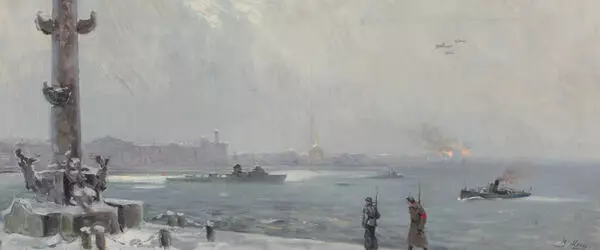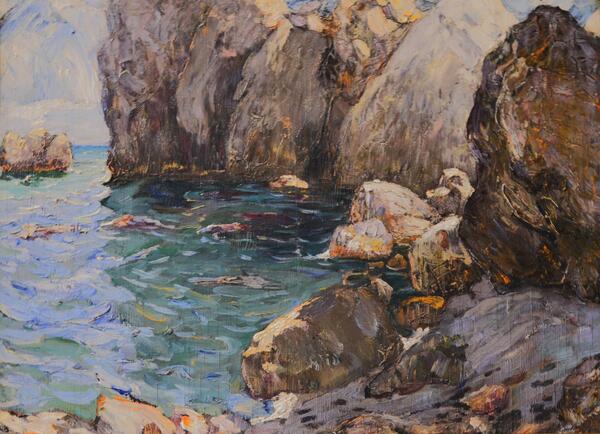The painting “River. Flood” is presented in the interior “Living room of the writer F.V. Gladkov”.
Vasily Vasilyevich Meshkov mainly painted cityscapes. In 1914, during the First World War, he served as an artist of the Army Headquarters. During that time, he created numerous studies depicting the war. After 1917, he worked as a theater artist. In 1922, the painter joined the Association of Artists of Revolutionary Russia. After his trip to Crimea and the Caucasus from 1924 to 1925, Meshkov returned to landscape painting.
During the Great Patriotic War, Vasily Meshkov visited the front on several occasions. As a result, he created a series of works on a military theme in 1944, including a series of paintings under the general title “On the Roads of Retreat of the Nazis.”
After the war, Meshkov worked fruitfully in his favorite landscape genre. His canvases were distinguished by a special majestic and severe interpretation of Russian nature.
The painting “River. Flood” was created in the artist’s characteristic “silver” manner and echoes such famous paintings of his as “Gray Day”, “Silver Rain”, “Cold”, “After the Rain”, and “Lake”. His landscapes convey the poetic state of nature, consonant with the mood of his soul. The landscapes of Vasily Meshkov are shrouded in a silver haze; they enchant the viewer, evoking the love for the Motherland, for its groves, fields, meadows, and rivers.
The picture accurately renders the state of nature awakening after a long winter. The low gray clouds are echoes of winter and cold, but there is no ice on the river, the young grass along the banks is emerald-green, and tender young leaves cover the tops of trees. The waters of the river are trying to overflow the banks. At first glance, the landscape looks simple and even mundane — a high bank and the vague outlines of gray houses or sheds on the hill behind the trees. However, after studying this unpretentious picture for a longer time, the viewers achieve the state of quiet joy.
This is such a familiar landscape. Motherland. That Motherland, for which bloody battles were fought somewhere. After all, the picture was painted in 1944. The war was still going on, but the victory was near. Faith in victory was getting stronger, like a river flooding in spring. It is interesting that Meshkov initially called the painting “Spring”.
According to the memoirs of Boris Fyodorovich Gladkov, the writer’s son, the painting was presented to Fyodor Vasilyevich by the artist Vasily Vasilyevich Meshkov, with whom the writer’s family maintained friendly relations.
Vasily Vasilyevich Meshkov mainly painted cityscapes. In 1914, during the First World War, he served as an artist of the Army Headquarters. During that time, he created numerous studies depicting the war. After 1917, he worked as a theater artist. In 1922, the painter joined the Association of Artists of Revolutionary Russia. After his trip to Crimea and the Caucasus from 1924 to 1925, Meshkov returned to landscape painting.
During the Great Patriotic War, Vasily Meshkov visited the front on several occasions. As a result, he created a series of works on a military theme in 1944, including a series of paintings under the general title “On the Roads of Retreat of the Nazis.”
After the war, Meshkov worked fruitfully in his favorite landscape genre. His canvases were distinguished by a special majestic and severe interpretation of Russian nature.
The painting “River. Flood” was created in the artist’s characteristic “silver” manner and echoes such famous paintings of his as “Gray Day”, “Silver Rain”, “Cold”, “After the Rain”, and “Lake”. His landscapes convey the poetic state of nature, consonant with the mood of his soul. The landscapes of Vasily Meshkov are shrouded in a silver haze; they enchant the viewer, evoking the love for the Motherland, for its groves, fields, meadows, and rivers.
The picture accurately renders the state of nature awakening after a long winter. The low gray clouds are echoes of winter and cold, but there is no ice on the river, the young grass along the banks is emerald-green, and tender young leaves cover the tops of trees. The waters of the river are trying to overflow the banks. At first glance, the landscape looks simple and even mundane — a high bank and the vague outlines of gray houses or sheds on the hill behind the trees. However, after studying this unpretentious picture for a longer time, the viewers achieve the state of quiet joy.
This is such a familiar landscape. Motherland. That Motherland, for which bloody battles were fought somewhere. After all, the picture was painted in 1944. The war was still going on, but the victory was near. Faith in victory was getting stronger, like a river flooding in spring. It is interesting that Meshkov initially called the painting “Spring”.
According to the memoirs of Boris Fyodorovich Gladkov, the writer’s son, the painting was presented to Fyodor Vasilyevich by the artist Vasily Vasilyevich Meshkov, with whom the writer’s family maintained friendly relations.





